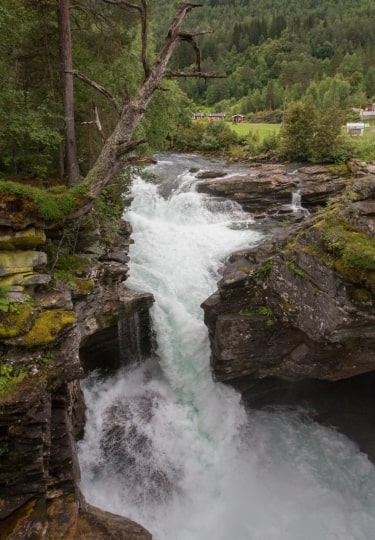In forested, mountainous Norway, Europe’s northernmost country, waterfalls are a regular feature of the lush landscapes.
Waterfalls in Norway are as dramatic as they are hypnotic. As winter’s snow melts, the mildest season of the year sees powerful falls cascade over towering cliffs. Wide-eyed travelers can also experience snow-capped mountains, deep fjords, and the undulating meadows that surround the country’s waterfalls.
From the capital, Oslo, to deep in the country’s southwest fjords region, discover the 16 most gorgeous waterfalls to see on vacation in Norway.
Seven Sisters Waterfalls, Geiranger
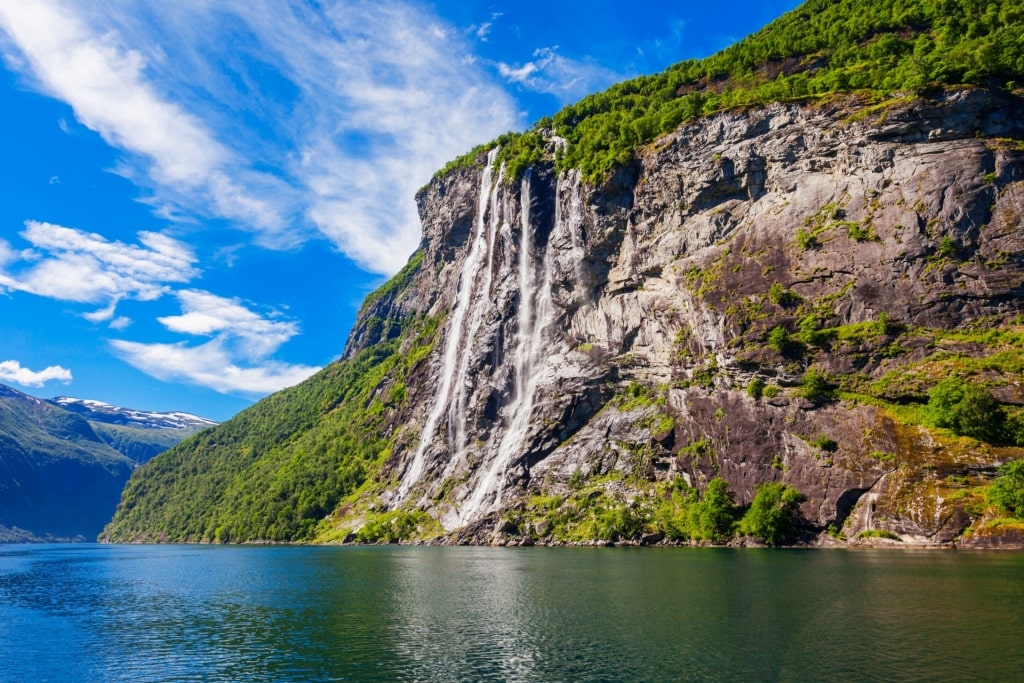
Seven Sisters Waterfalls, Geiranger
There are a number of ways to gaze at the head-turning Seven Sisters Waterfalls, also known as Knivsflåfossen, near Geiranger.
Spilling vertically into the UNESCO-listed Geirangerfjord, the seven falls drop an extraordinary 820 feet.
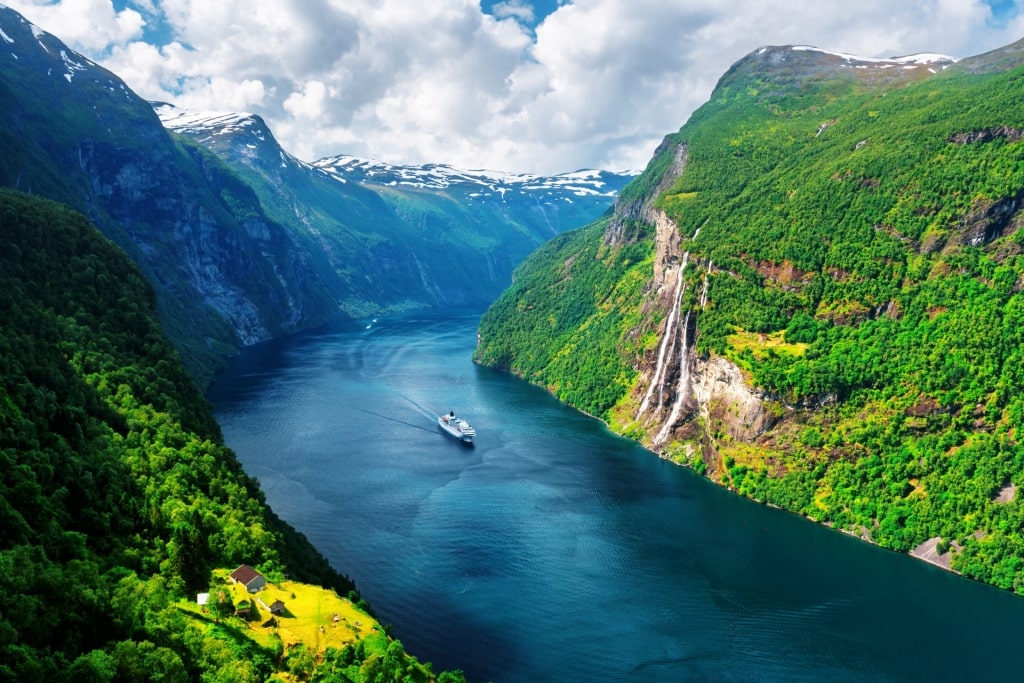
Seven Sisters Waterfalls, Geiranger
Join a ferry or RIB boat trip from Geiranger for some of the best views of the Seven Sisters. Another option that will get you even closer to the water is to join a guided kayak tour. Starting in Geiranger harbor, you’ll paddle down the fjord to reach the Seven Sisters.
On land, consider tying in a trip to the Seven Sisters with a visit to Knivsflå, an abandoned farm perched around 850 feet up the mountain. Knivsflå provides fantastic fjord and mountain views.
Tvinde Waterfall, near Flåm

Tvinde Waterfall, near Flåm
Tvindefossen is positioned seven miles north of Vossevangen in southwest Norway, a fjord town home to a gondola, a folk museum, and a thrilling river for rafting adventures.
Travelers can view the dazzling Tvindefossen without needing to turn off the main highway. The drop is 360 feet, cascading in multiple tiers as it fans the mountainside.
Less than one mile north of Tvindefossen is Voss Active, where adrenaline-seeking visitors can explore the high rope course, zip-line, rafting, canyoning, and canoeing on the Vosso River.
Steinsdalsfossen Waterfall, near Bergen
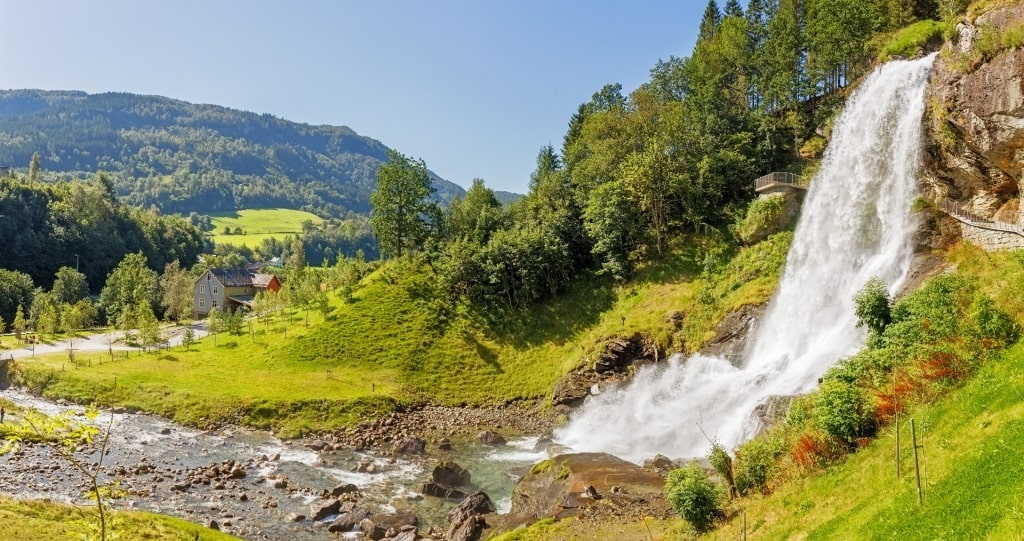
Steinsdalsfossen Waterfall, near Bergen
The Fosselva River’s rapid Steinsdalsfossen, near Norheimsund, is one of the best waterfalls to experience in Norway. Why? Because visitors can walk behind the sensational falls without even getting wet.
Make the 75-minute drive from Bergen to Steinsdalsfossen and follow the riverbank path from the parking lot that leads behind the waterfall.
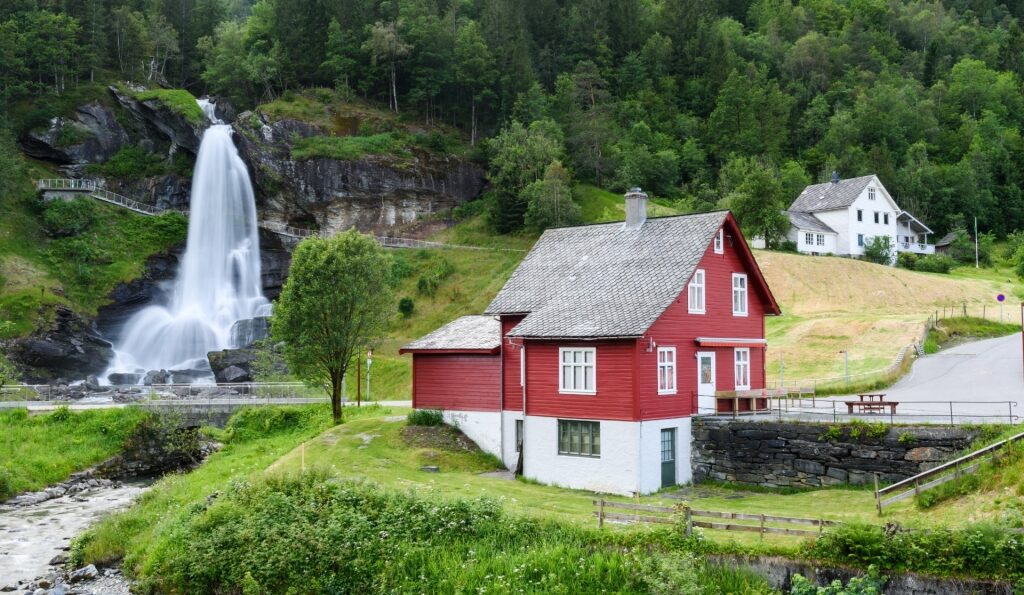
Steinsdalsfossen Waterfall, near Bergen
Visitors emerge from the other side of Steinsdalsfossen onto a viewing platform that provides captivating views of Norheimsund and the luscious Steinsdalen valley.
Once you’ve admired Steinsdalsfossen’s 164-foot fall, make your way to the café for a bite to eat.
You could also visit the Hardanger Maritime Centre in Norheimsund, a popular pitstop on the Norwegian Scenic Route. There’s a fascinating small-boat workshop, ship preservation areas, and an exhibition on the craft of rope-making.
Vøringsfossen, near Flåm

Vøringsfossen, near Flåm
A two-hour drive south of Flåm leads to Vøringsfossen in the Hardangerfjord region, one of the most spectacular waterfalls in Norway.
Here, travelers get to marvel at Vøringsfossen’s water plummeting almost 600 feet into the Måbødalen valley below.
Vøringsfossen’s modern viewing bridge, opened in 2020, spans 154 feet. Situated near the Fossli Hotel, the bridge offers dramatic views of the water falling from the Hardangervidda plateau.
Travelers unable to climb the viewing bridge’s 99 steps can opt to admire Vøringsfossen from its base in the valley.

Vøringsfossen, near Flåm
There’s been a road in place from Måbødalen to Fossli since 1916. Before this, travelers had to conquer the 1,300 stone steps carved into the valley.
After discovering the waterfall, tag on a trip to the Norwegian Nature Centre Hardanger at the foot of the waterfall. The center explores nature, climate and environment, and their intertwined connection, through exhibitions and cinema.
Vettisfossen, near Flåm

Vettisfossen, near Flåm
Vettisfossen dazzles travelers in the Hardangerfjord region of Norway so much so that 20th-century Norwegian writer Jan Schwarzott once described it as the queen of waterfalls.
Although it’s not the tallest waterfall in the country—that accolade goes to Vinnufallet in northwest Norway—Vettisfossen is one of the most powerful, foaming 902 feet into the Utladalen valley.
You’ll need to be reasonably fit to witness Vøringsfossen, as it involves trekking a section of the forested valley, part of the Jotunheimen mountain range near Øvre Årdal.

Hjellefossen Waterfall, near Flåm
Hjellefossen waterfall is located around three miles away. Since there’s parking here, many travelers use this as a start and end point to tackle both waterfalls on an endorphin-releasing hike.
Remember to stop for regular breaks to take in the awe-inspiring landscape of emerald-green mountains that are often still snow-capped, even during summertime, surrounding the mighty falls.
Gudbrandsjuvet Waterfall, near Alesund
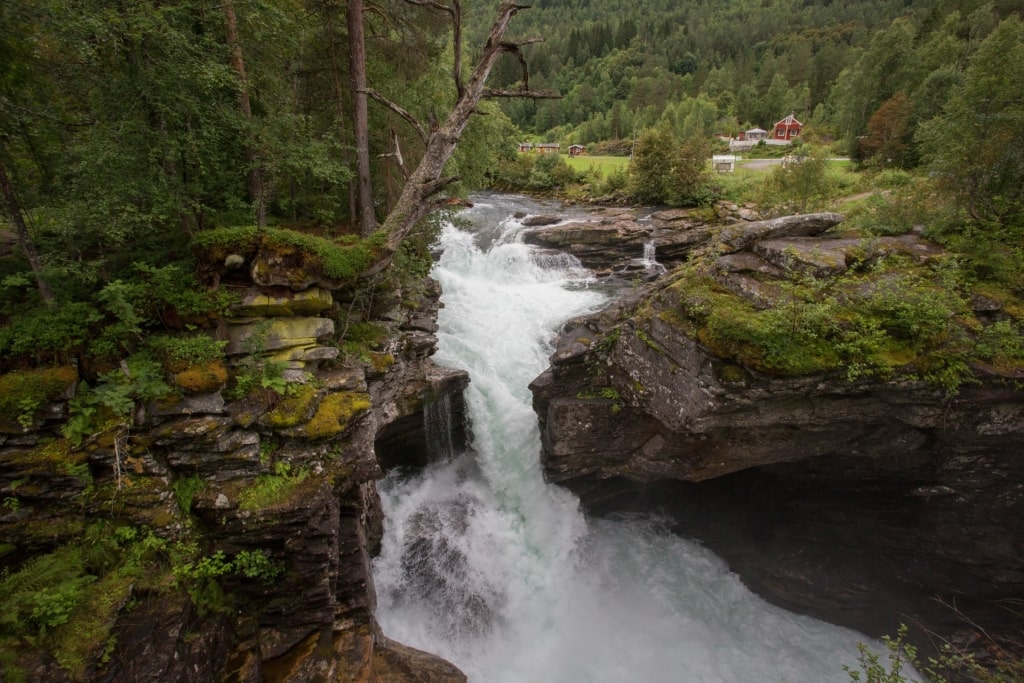
Gudbrandsjuvet Waterfall
The slim Gudbrandsjuvet near Åndalsnes spills through a ravine in the Valldøla River in the Norwegian fjords.
Roughly a 90-minute drive from Alesund, located in one of the country’s most breathtaking settings, Gudbrandsjuvet’s 82-foot drop is among the most picturesque waterfalls in Norway.
Thick snow drifts make way for a swathe of greenery by early summer, when travelers can trace the walkway around Gudbrandsjuvet.
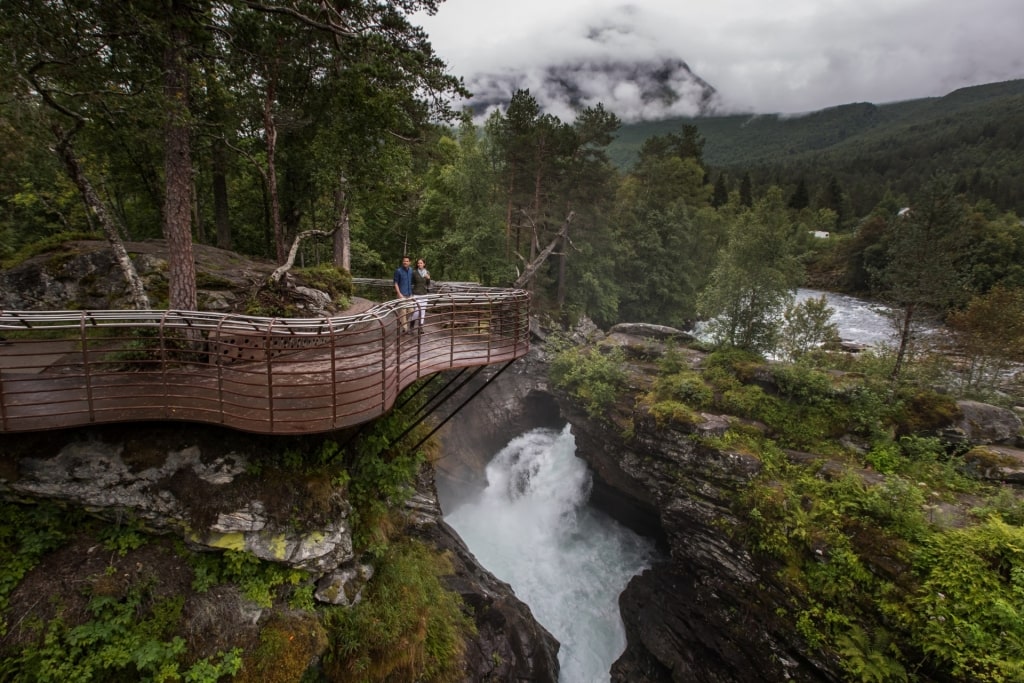
Gudbrandsjuvet Waterfall, near Alesund
There are several hiking routes to try around the waterfall and the fast-flowing Valldøla River. Follow the scent of sticky cinnamon buns to the dazzling café that overlooks the waterfall. Take a table by the floor-to-ceiling windows.
Tempting items such as warming fish soup, fresh local strawberries and ice cream, and velvety coffee are also on the menu.
Read: Best Places to Go Hiking in Norway
Kjosfossen Waterfall, Flåm

Kjosfossen Waterfall, Flåm
The wonderful Kjosfossen is a highlight of a journey on the historic Flåm Railway, lying at the innermost point of the Aurlandsfjord in southwest Norway. Take the train from the enchanting village of Flåm to reach Kjosfossen.
Tumbling 305 feet, the waterfall comes into full view as train passengers step off the ascending line. Feel the waterfall’s refreshing spray as you take photographs and soak up the mind-blowing views that Norway is known for.

Flåmsbana
After, continue your journey on the Flåm Line, also known as Flåmsbana, which runs 12.6 miles up to the mountain village of Myrdal. Gaze out at Flåm Valley’s forested mountains from your vintage train compartment.
The extraordinary one-hour journey passes 10 stations, through 20 mountain tunnels, and reaches a height of 2,844 feet. The Nali tunnel, alone—between Kardal and Pinnalia stations—took 11 years to build.
You could also combine a trip to Kjosfossen with Flåm’s eye-watering zip line, which whisks dare-devil adventurers 4,530 feet through the air.
Storsæterfossen, Geiranger
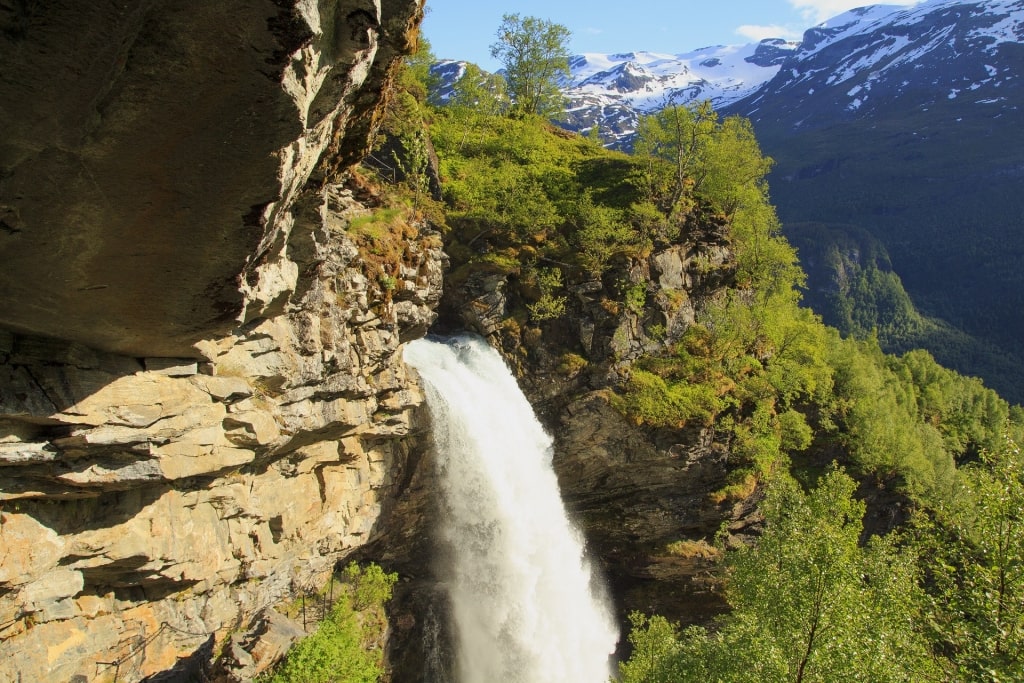
Storsæterfossen, Geiranger
Storsæterfossen is a magical waterfall just outside of Geiranger. The drive here is short, but spectacular.
The hike from Geiranger to Storsæterfossen is equally rewarding and takes around one hour, depending on your pace.
Follow the coiling Route 63 by car or foot to Vesterås farm, from where there are two mood-lifting hikes to choose from.
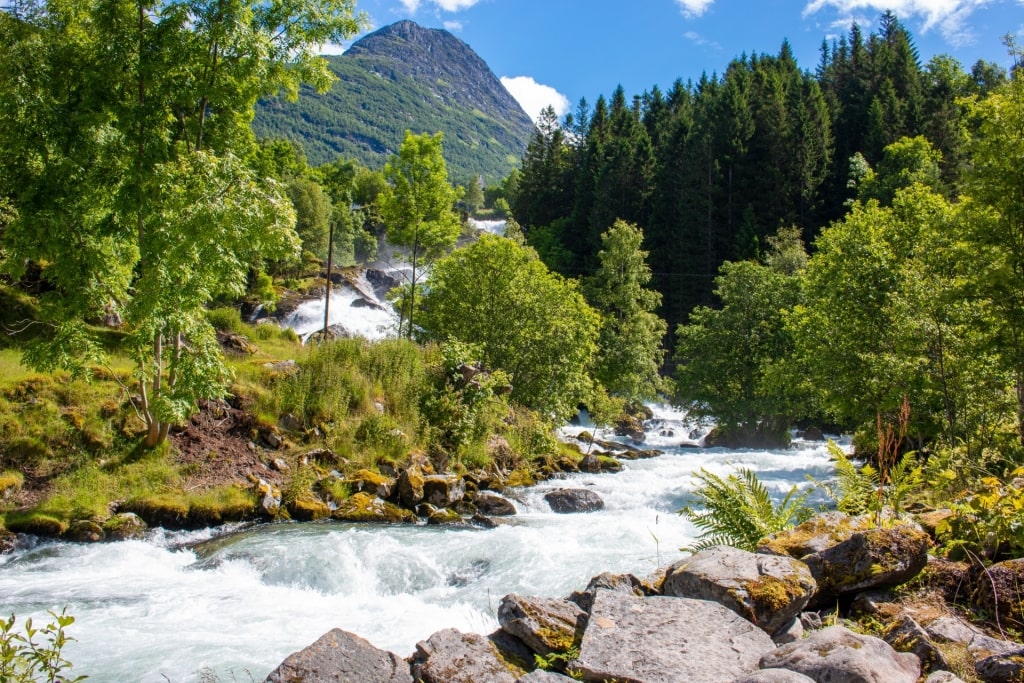
Storsæterfossen, Geiranger
One path follows hundreds of steps built by Nepalese sherpas in 2014. The alternative route is shorter, but steeper. Both routes eventually meet before arriving at the breathtaking Storseterfossen.
Take in the far-reaching views from the waterfall’s summit before following the trail carved into the rockface to venture behind the curtain of white water.
Stigfossen, near Alesund
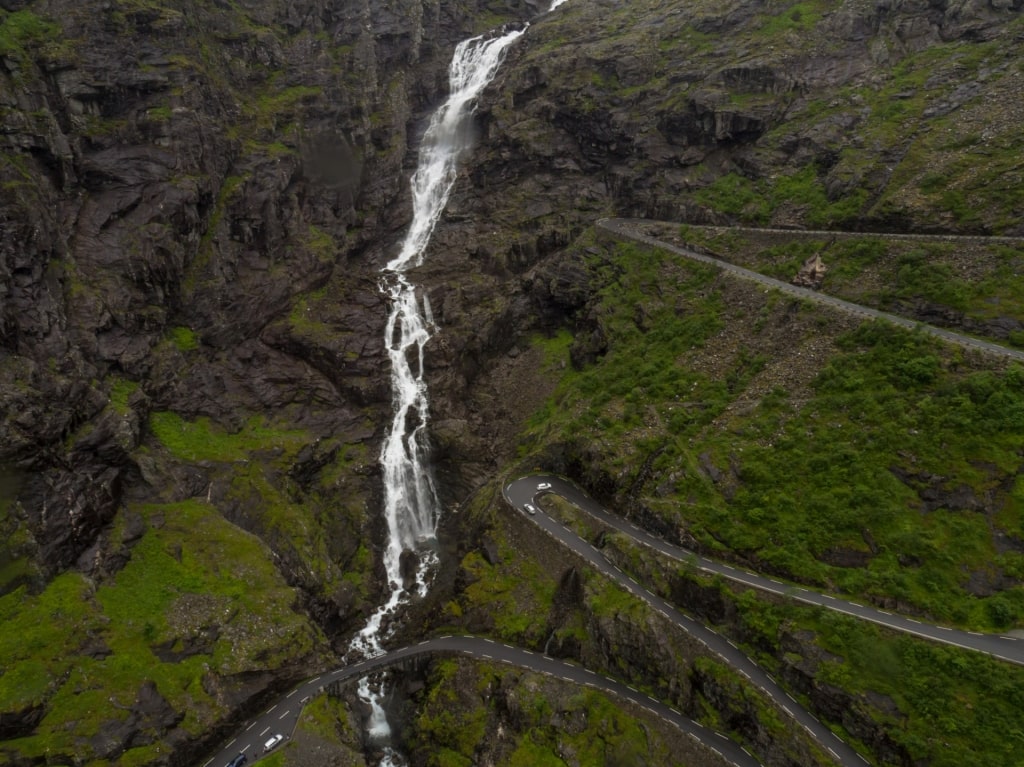
Stigfossen, near Alesund
Stigfossen cuts through the serpentine Trollstigen, a bucket list-worthy road that zigzags over the course of 11 twists and turns on Norway’s mountains.
Buckle up for the remarkable drive to Trollstigen. The journey takes two hours from Alesund, following the Romsdalsfjord east before skirting south of Åndalsnes.
The narrow Trollstigen, which roughly translates as the “trolls’ ladder”, is famous for its switchbacks and steep mountainsides, with the path reaching an elevation of 2,790 feet. The famous route took eight years to construct and was opened in 1936 by King Haakon VII.
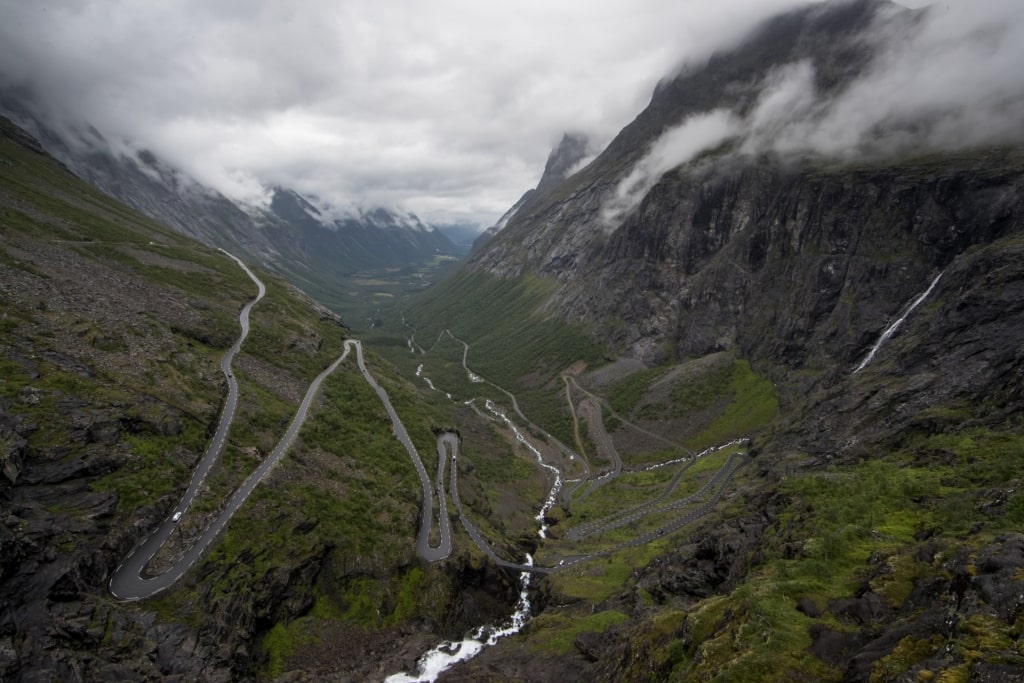
Trollstigen, near Alesund
Due to Trollstigen’s hazardous conditions the road is closed for part of the year, making summer the best time to visit.
At the 2,300-foot mark there is a parking lot where you can take in the magnificent views of Stigfossen.
If the Trollstigen Kafe is open, stop by for local dishes of goat’s cheese salad, reindeer with confit potatoes, and honey-mustard salmon.
Kjelfossen, near Bergen
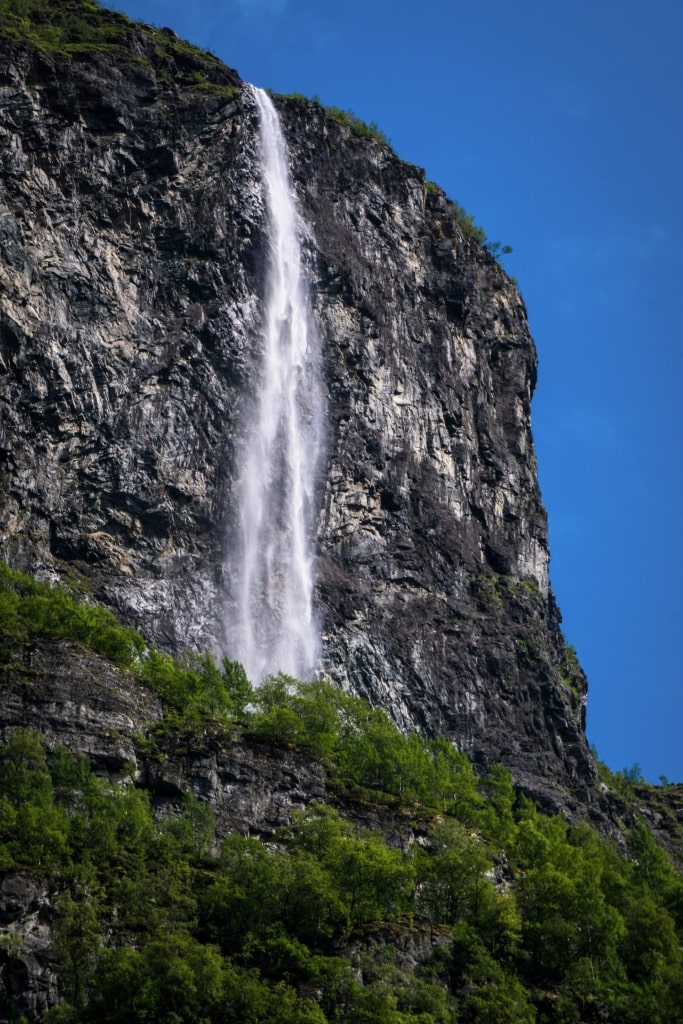
Kjelfossen, near Bergen
Kjelfossen is a mesmerizing waterfall located in Gudvangen near Bergen. The drop is one of the most beautiful waterfalls in Norway, plunging 2,477 feet over multiple tiers.
Kjelfossen can be seen from Gudvangen’s photogenic waterfront. It’s especially powerful during early summer, when water thunders down the soaring mountain.
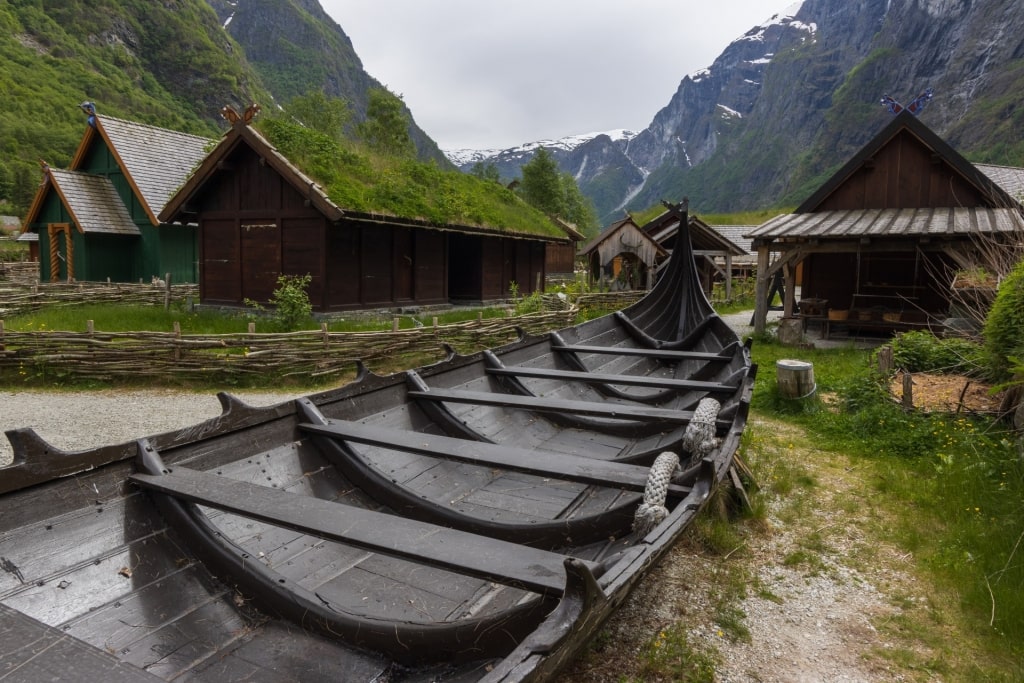
Njardarheimr
After admiring Kjelfossen, explore the region’s Viking history on a visit to Gudvangen’s Viking town, Njardarheimr. Join a guided tour of the village to gain an immersive insight into how Vikings lived before tucking into a banquet served in Njardarheimr’s food house.
Mongefossen, near Ålesund

Mongefossen, near Ålesund
Glorious Mongefossen is one of the largest waterfalls in Norway and one of the highest single-drop waterfalls on the planet.
Located near the 42-mile long Rauma River in the rugged Møre og Romsdal, Mongefossen is fed from the lofty Mongevatnet, a lake set at an elevation of 4,068 feet.

Kors Church, Marstein
Look out for the nearby Kors Church in the village of Marstein. The mocha-colored timber church was built in 1797 and is lined with craggy gravestones and dotted with silver birch trees.
Pack your camera. The church’s backdrop of soaring saw-toothed mountains is like a real-life painting.
Read: Serene Lakes in Norway to Visit
Stalheimsfossen, near Bergen
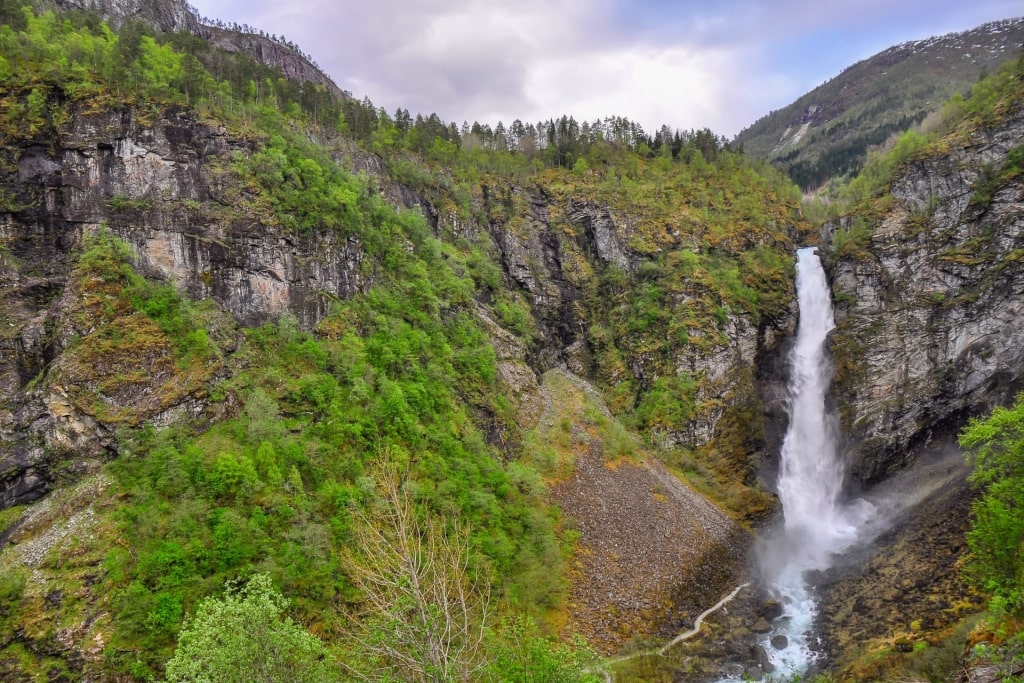
Stalheimsfossen, near Bergen
Just over two hours from Bergen, Stalheimfossen lies outside the bucolic village of Stalheim in the Nærøy valley.
The 413-foot waterfall is near the now-closed Stalheimskleiva, another of Norway’s twisting and turning serpentine roads. Though visitors can no longer traverse the hair-raising section of road, they can visit the nearby open-air Stalheim Museum of Cultural History for its true-to-life pastoral buildings.
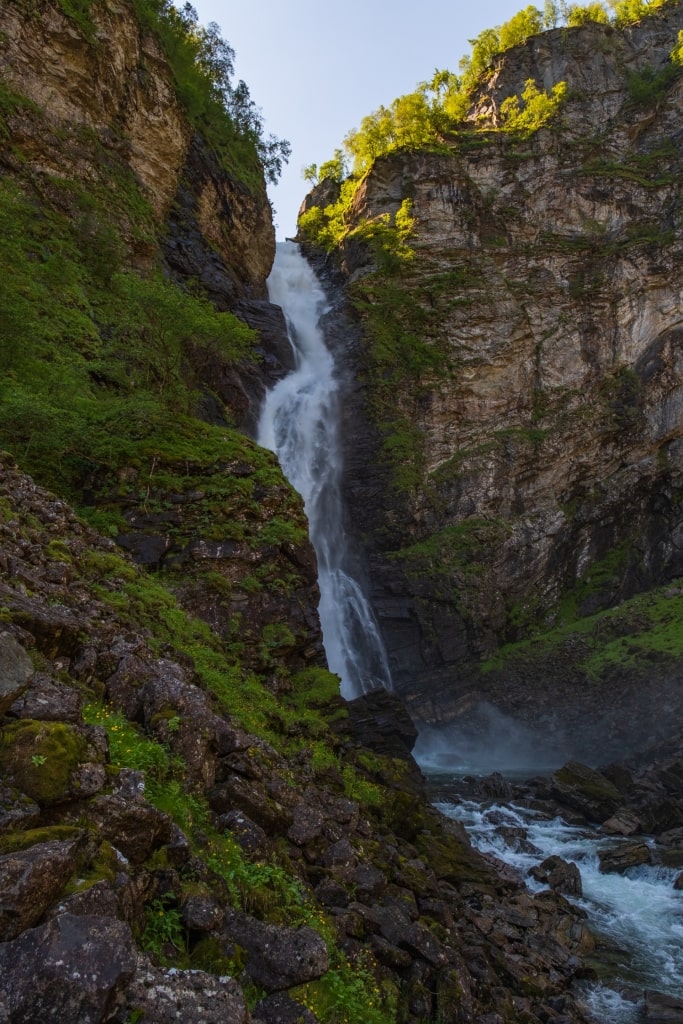
Stalheimsfossen, near Bergen
Start your journey to Stalheimsfossen at the museum, which takes around 10 minutes on foot. Stalheimsfossen falls from a small opening in the rockface, forming a slender stream down the mountainside into the Nærøydalselvi River, a short waterway that’s populated with salmon.
Langfoss Waterfall, near Haugesund
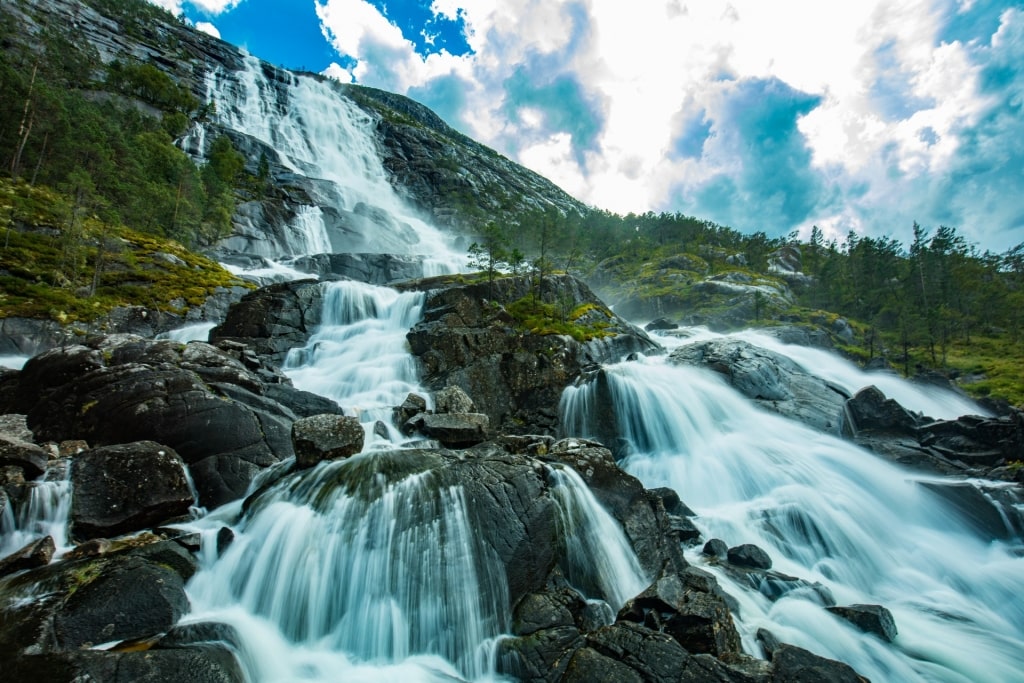
Langfoss Waterfall, near Haugesund
This veil of bubbling water nosedives 1,968 feet into the Åkrafjorden, near the small village of Fjæra, around 90 minutes from Haugesund.
Langfoss is staggeringly beautiful and although you can view it from the roadside without stopping, you’ll want to take the time to absorb this exquisite landmark.
There’s a parking lot and refreshment kiosk next to the waterfall. Stop here to enjoy a picnic as you listen to the water rumble down the cliff.
Månafossen, near Stavanger

Månafossen, near Stavanger
This powerful waterfall is just over an hour’s drive from Stavanger in south Norway, set in the scenic Frafjordheiane conservation area.
A short but testing hike is required to get to Månafossen. It’s well worth the effort to see the superb Månafossen in action, with a torrent of water pouring around 328 feet through a narrow gorge into the Frafjordelva River.
Start from the parking area in Eikeskog and follow the designated route up to Månafossen into the Fidjadalen valley. The path becomes steeper and less defined, with stone steps along the way.

Månafossen, near Stavanger
Stop at the viewpoints to capture the roaring Månafossen. Continue past the waterfall to the restored mountain farm in Mån, where you can enjoy a scenic break facing the trout-filled Frafjordelva.
A return trip from the parking lot to Månafossen takes around one hour, while the trek to the farm is around two hours.
Ramnefjellsfossen, Olden
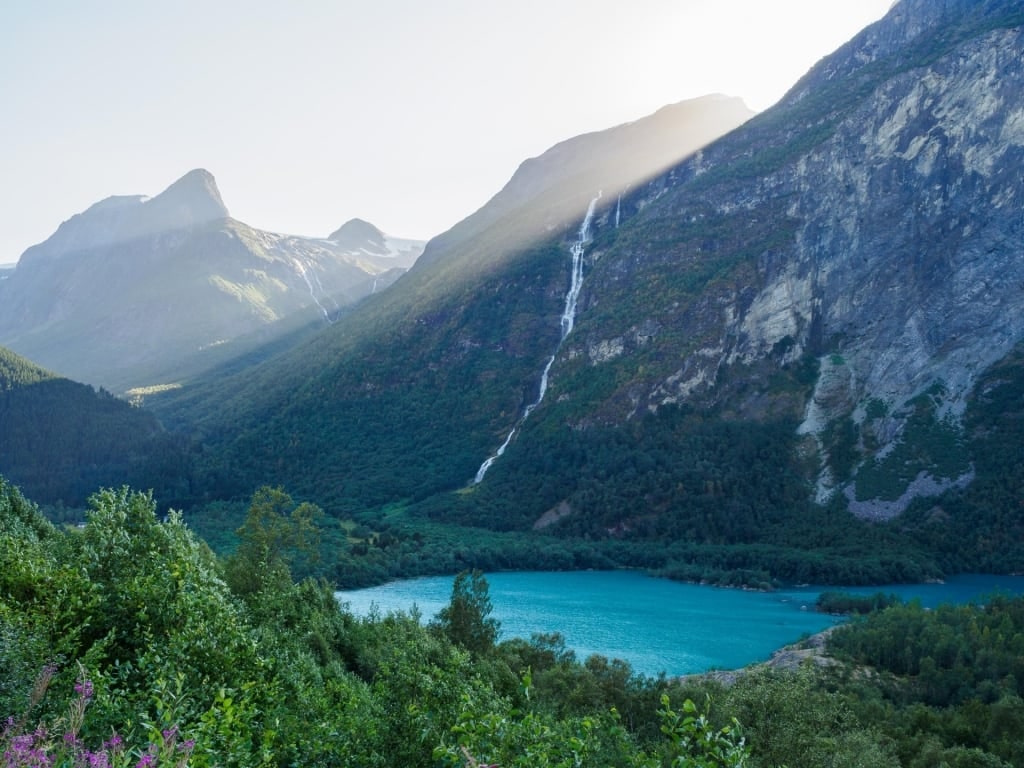
Ramnefjellsfossen, Olden
The horsetail-like Ramnefjellsfossen feeds into Lovatnet, a teal-colored lake around six miles southeast of Olden and Loen. Ramnefjellsfossen drops around 2,684 feet, making it one of the tallest waterfalls in Norway.
The water flows from the Ramnefjellbreen glacier, a branch of the largest glacier in continental Europe, the Herculean Jostedalsbreen.
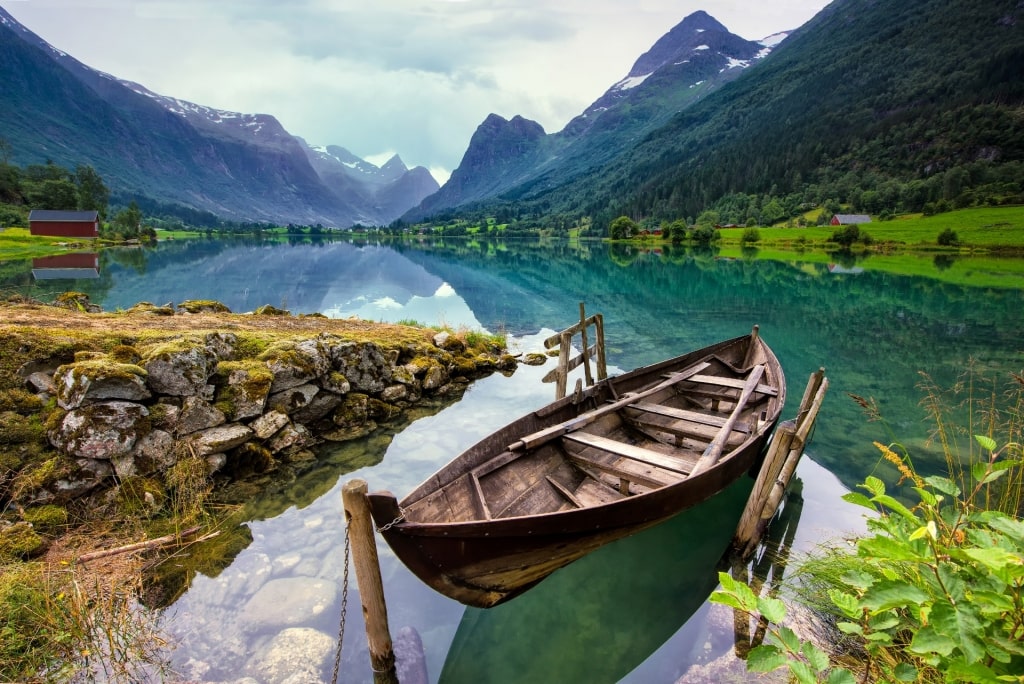
Lake Loen
Travelers can visit Ramnefjellsfossen by boat, road, or even on an exhilarating seaplane ride. Opt for a relaxing cruise on Lake Loen to witness west Norway’s sweeping alpine landscape from the water.
Vøyenfallene, Oslo
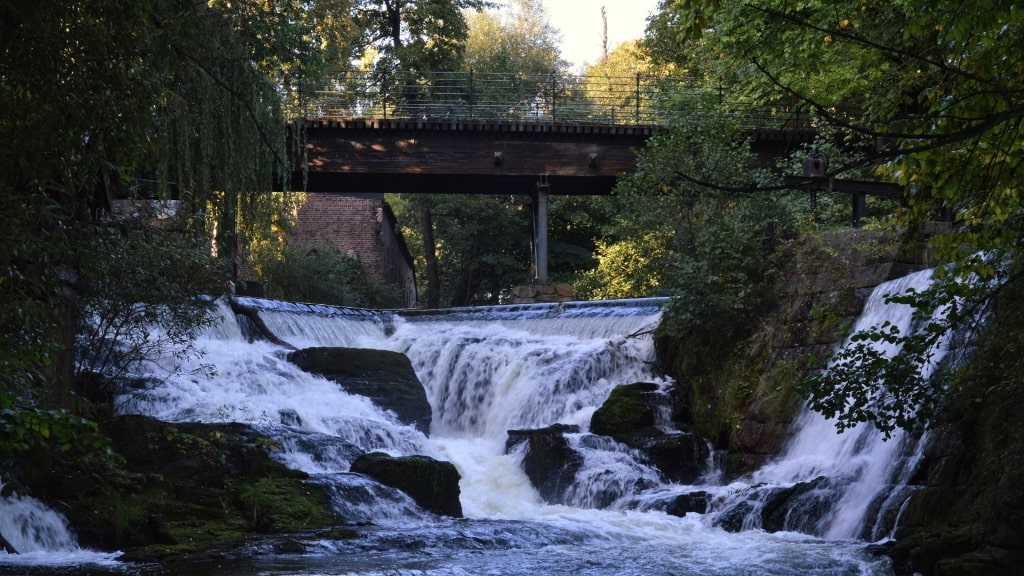
Vøyenfallene, Oslo Photo by Ryan Hodnett on Wikimedia Commons, licensed under CC BY-SA 4.0
As far as waterfalls in Norway go, Vøyenfallene is unique in that it lies in Oslo, the country’s vibrant capital.
Look beyond Oslo’s grand buildings and many museums, such as the Royal Palace and the Astrup Fearnley Museum of Modern Art, and there are plenty of green spaces. You’ll also discover Vøyenfallene, an urban waterfall that is a thing of beauty.
The charming waterfall lies on the city’s snaking Akerselva River in the Torshov neighborhood, just north of Grünerløkka. Starting in Maridalsvannet, the largest lake in Oslo, the river meanders south to the Oslofjord.

Grünerløkka, Oslo
Immerse yourself in the city’s soothing nature by following the river trail through Oslo’s greenery to first reach Grünerløkka. One of Oslo’s most stylish neighborhoods, Grünerløkka is home to evocative street art, cool cafés, and independent restaurants. There’s a smaller waterfall, Nedre Foss, too, which you will see by following the riverside path.
Weave through Vøyenparken, a pretty park on the right bank of the river to arrive at Vøyenfallene, crossing Beierbrua Bridge for some of the best views of the cascading water.
You could also visit Vøyenparken’s Hønse-Lovisa’s House behind the waterfall. This small red cottage, built in 1800, is named after a character in the books by Norwegian novelist Oskar Braaten. There’s a delightful café here, too, where you can stop for coffee, cake, or even a beer.
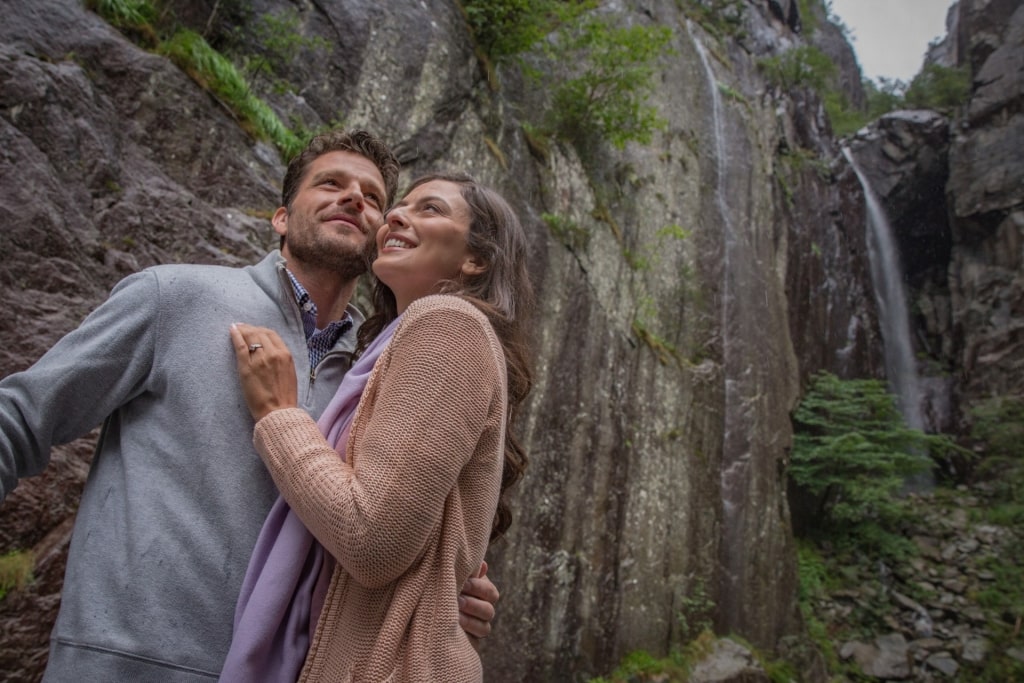
Lysefjord
Norway’s landscape is one of the most beautiful in the world. Explore Celebrity’s cruises to Norway to experience waterfalls and a host of other natural landmarks.
